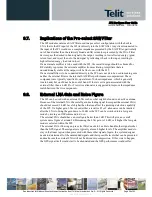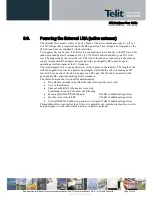
JF2 Hardware User Guide
1vv0300985 Rev.4 2013-04-09
Reproduction forbidden without written authorization from Telit Communications S.p.A. - All Rights Reserved.
Page 38 of 40
Mod. 0805 2011-07 Rev.2
12.2.
ESD
The JF2 is an electrostatic discharge sensitive device and should be handled in accordance
with JESD625-A requirements for Handling Electrostatic Discharge Sensitive (ESDS)
Devices. Although the JF2 is a module, the expecting handling of the JF2 during assembly
and test is identical to that of a semiconductor device.
Note:
JEDEC standards are available for free from the JEDEC website http://www.jedec.org.
12.3.
Reflow
The JF2 is compatible with lead free soldering processes as defined in IPC/JEDEC J-STD-
020. The reflow profile must not exceed the profile given IPC/JEDEC J-STD-020 Table 5-2,
“Classification Reflow Profiles”. Although IPC/JEDEC J-STD-020 allows for three reflows,
the assembly process for the JF2 uses one of those profiles. Thus the JF2 is limited to two
reflows.
Note:
JEDEC standards are available for free from the JEDEC website http://www.jedec.org.
When reflowing a dual-sided SMT board, it is important to reflow the side containing the JF2
module last. This prevents heavier components within the JF2 becoming dislodged if the
solder reaches liquidus temperature while the module is inverted.
12.4.
Assembly Issues
Due to the piezo-electric components within the JF2, the component should be placed close to
the end of the assembly process to minimize shock to the module. During board singulation,
pay careful attention to unwanted vibrations and resonances introduced into the board
assembly by the board router.

















